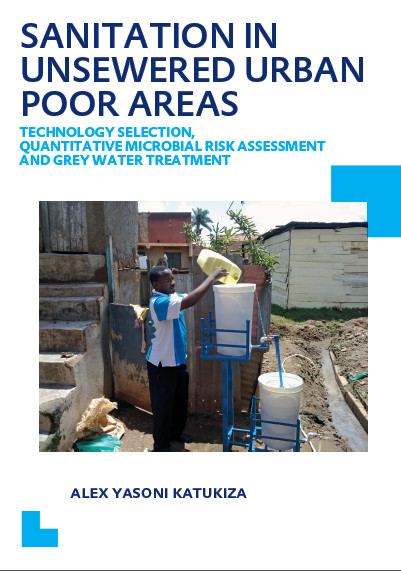Sanitation in unsewered urban poor areas
 |
technology selection, quantitative microbial risk assessment and grey water treatment
thèse Jan 2013 ; 272 pages
Aut. Alex Yasoni Katukiza
Ed. TU Delft - Delft
Téléchargeable sous format: PdF
Téléchargeable chez l'éditeur
Page de présentation d'un éditeur
Abstract:
The sanitation crisis in unsewered urban slums of cities in developing countries is one of the challenges that need to be addressed. It is caused by the high rate of urbanisation in developing countries and the increasing urban population with limited urban infrastructure. The major issues of concern are the collection, treatment and safe disposal of excreta, grey water and solid waste. The goal of this study was to contribute to the sanitation improvement in urban slums with focus on sanitation technologies.
A review of sanitation technology options for urban slums was made followed by a baseline study in the slum of Bwaise III in Kampala Uganda. The results from the situation assessment and analysis were used to develop a method for selection of sustainable sanitation technologies in urban slums. Quantitative microbial risk assessment was then carried out based on the sources and concentration of pathogens and indicator organisms in the slum environment. The risk of infection and the disease burden contribution from various exposure pathways were determined. The study then focused on grey water treatment using a low-cost media (sand, crushed lava rock) based systems at laboratory scale and household level in the study area.
The results show that grey water treatment using a two-step crushed lava rock filter at household level in an urban slum has the potential to reduce the grey water pollutant loads by 50 % to 85%. However, its impact on public health and the environment needs to be assessed after its wide application. The need for advanced removal of pathogens and micro-pollutants from grey water warrants further research. In addition, the management systems for other waste streams of excreta and solid waste need to be in place as well to achieve the desired health impacts in urban slums. Integration of quantitative microbial risk assessment (QMRA) in the selection process of sustainable sanitation technologies for urban slums is recommended for future studies aimed at providing a holistic approach for upgrading slum sanitation. This will help to further understand the health impacts and benefits of sanitation solutions and also provide support to local authorities in making decisions on the measures to reduce the disease burden and environmental pollution.
Mots clefs: |
assainissement (CI) (DT) (OP) (ope) , eaux usées (évacuation des ) (CI) (DT) (OP) (ope) , péri-urbain (CI) (DT) (OP) (ope) , population à faible revenus (CI) (DT) (OP) (ope) , toilettes, latrine (CI) (DT) (OP) (ope) |
Pays concerné: |
Editeurs/Diffuseurs: |
|
TU Delft
-
Delft University of Technology - Delft - Pays Bas |
IHE
-
Institute for Water Education - Delft - Pays Bas |
En cas de lien brisé, nous le mentionner à communication@pseau.org